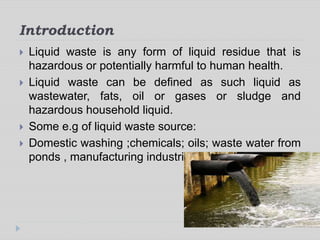The Buzz on Reclaim Waste
Table of ContentsExcitement About Reclaim WasteUnknown Facts About Reclaim WasteThe Best Guide To Reclaim WasteEverything about Reclaim WasteReclaim Waste Things To Know Before You Get This
Discover the types, events, and forms of liquid waste. Residential sewer waste describes the waste and items from a residential septic storage tank. This kind of waste is produced by human beings in homes, institutions, and other structures. This only consists of septic tanks that have a drainpipe area. The correct monitoring and disposal of domestic sewage waste call for liquid waste to be transferred to a sewage therapy plant where the correct approaches and devices are applied to cleanse and take care of waste.
Industrial waste typically consists of possible dangers, such as combustible products or a mixture of liquid and strong waste products, and requires a much more sophisticated and comprehensive disposal process. The disposal of commercial waste usually includes the purification of waste prior to transportation to make sure safe and proper disposal. Industrial waste is produced from byproducts and drainage of industrial procedures and production.
This type of waste can not use the same sewage monitoring transportation or processes as septic or commercial liquids. The commercial waste monitoring process requires the examination and screening of fluid waste before it goes through the disposal process (liquid waste disposal melbourne). Runoff waste is the fluid waste that originates from drainage and excess stormwater in extremely booming locations or cities
Runoff waste can trigger contamination and flooding if not handled appropriately. Guaranteeing appropriate waste management can avoid disasters and lower ecological harm.
Little Known Facts About Reclaim Waste.
Call PROS Providers today to discover concerning our waste monitoring and disposal solutions and the correct methods to take care of the fluid waste you produce.
(https://www.twitch.tv/reclaimwaste1/about)This so-called 'wastewater' is not only an essential source yet, after treatment, will be launched to our land, waterways or the ocean. Made use of water from toilets, showers, bathrooms, kitchen area sinks, laundries and industrial processes is recognized as wastewater.

water utilized to cool down machinery or clean plant and devices). Stormwater, a type of wastewater, is overflow that moves from agricultural and metropolitan locations such as roofings, parks, yards, roadways, paths and rain gutters article source right into stormwater drains pipes, after rain. Stormwater flows untreated straight to neighborhood creeks or rivers, at some point reaching the ocean.
Excitement About Reclaim Waste
In Queensland, the majority of wastewater is dealt with at sewage therapy plants. Wastewater is transferred from residential or industrial sites with a system of sewage systems and pump stations, known as sewage reticulation, to a sewage treatment plant. Regional governments construct, maintain and operate most sewage therapy plants. Operators are licensed under the Environmental Management Act 1994 to discharge cured wastewater at an appropriate ecological standard right into rivers.
The Division of Natural Resources recommends neighborhood federal governments concerning managing, operating and preserving sewage systems and therapy plants. In unsewered areas, city governments may call for owners to set up private or house sewage treatment systems to treat domestic wastewater from bathrooms, kitchens, shower rooms and laundries. The Division of Natural Resources authorises using home systems when they are confirmed to be effective.
In some brand-new communities, therapy of some stormwater to eliminate trash, sand and crushed rock has actually started utilizing gross pollutant traps. Wastewater therapy occurs in four stages: Gets rid of solid issue.
Wastewater after that streams into big storage tanks where solids clear up and are removed as sludge. Oil and scum are skimmed from the surface. Utilizes small living organisms knows as micro-organisms to break down and get rid of remaining liquified wastes and fine fragments. Micro-organisms and wastes are included in the sludge. Eliminates nitrogen and phosphorus nutrients that could trigger algal blooms in our waterways and endanger water life.
9 Simple Techniques For Reclaim Waste
Nutrient elimination is not offered at all sewer therapy plants because it requires pricey specialized devices. Clear fluid effluent created after therapy may still have disease-causing micro-organisms - liquid waste removal.

This usually means wastewater has to be dealt with or impurities removed prior to it can be released to rivers. Many wastewater streams into the sewerage system. Under the Act, regional governments provide authorizations and permits for ecologically pertinent tasks (Ages) including wastewater releases that could have a regional impact. The division provides approvals and permits to Ages entailing wastewater launches that could have a regional or statewide effect.
Reclaim Waste Fundamentals Explained
Or else, samples are considered lab evaluation. Typically lots of examinations are needed to develop the levels of each of the various contaminants such as oils, heavy steels and pesticides in water. Tracking offers factual information concerning water high quality and can confirm that licence problems are being met. The details gotten through tracking supplies the basis for making water top quality choices.